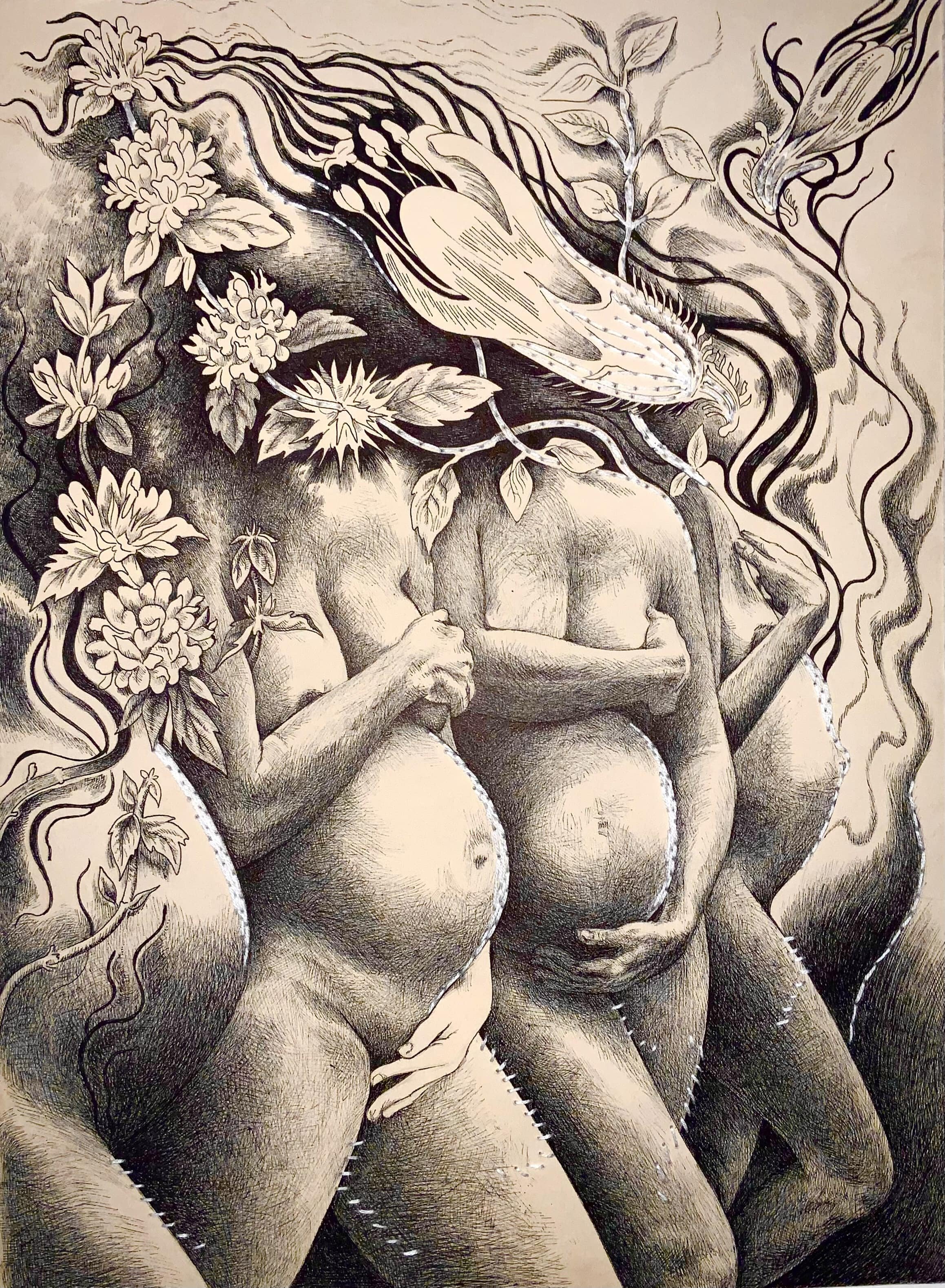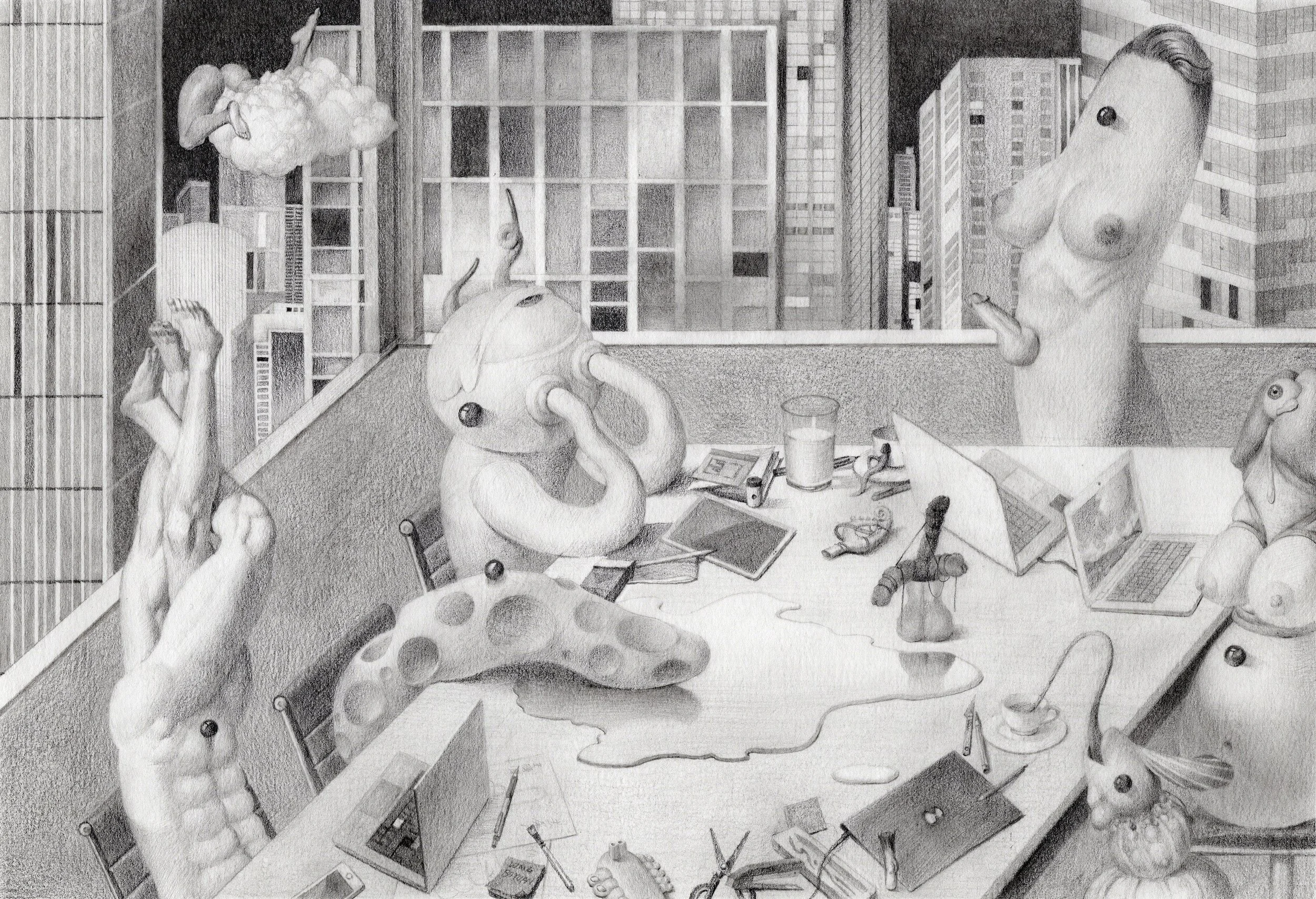10 Questions with Joanna Hoge
Al-Tiba9 Art Magazine ISSUE14 | Featured Artist
Joanna Hoge (she/they) is a queer artist and designer based in Denver, Colorado. They apply their background in psychology and interest in medicine to create works that explore the dynamic between subjective identity and objectifiable body.
Hoge received a BA from Saint Louis University in 2011 and an MFA from Southern Illinois University in Edwardsville in 2016. Their work has been exhibited both locally and nationally at galleries and venues, including the Arvada Center (CO), the Atlantic Gallery (NY), and Rosenthal Gallery (NC). They are the recipient of several grants, including an artist residency grant from the Horned Dorset Colony in upstate New York, a research grant for graduate students from Southern Illinois University in Edwardsville, and an Artist Support Grant from the Regional Arts Commission in Saint Louis.
Joanna Hoge - Portrait
ARTIST STATEMENT
Hoge's work is largely inspired by the division of somatic and psychological experiences in Western culture. We are often taught to view and treat our bodies and our minds separately. Hoge creates drawings that use anatomical rendering as a site for integration, blurring the lines between an objective, scientific understanding of the body's parts and a personal sense of embodiment.
Recently, Hoge's approach has shifted to address the social, emotional, and physical aspects of motherhood. They consider dichotomies: the strength of one's body to carry and nourish a child and the simultaneous precarity of pregnancy. Miscarriages are both ubiquitous and never spoken of. Motherhood is at once a choice and the implied default of womanhood; electing to be child-free often carries negative assumptions.
Through drawing, Hoge brings these contrasts into view: exploring the gaps between biology and identity.
Fray © Joanna Hoge
Limited edition magazine >>
INTERVIEW
How did you get involved with art, and what influenced you to follow this path?
From a young age, I used art as a way to process and understand my experiences. I was also fortunate enough to have parents who encouraged my efforts. Drawing was a means of creating new worlds, of exerting control, of feeling some sense of agency as a young person. Recognizing art as a conduit for connection early on, it became a lifeline I could never really let go of. I'm grateful to those who encouraged me along the way- and who never questioned my impulse to make things.
How did you develop into the artist you are today?
I owe my artistic development to many individuals, to my family, first and foremost, for creating a supportive environment in which to explore my ideas, no matter how strange. My time as an undergraduate at Saint Louis University proved especially fruitful; folks around me were invested in asking meaningful questions through their art practice- and in pushing the boundaries of their crafts. This theme re-emerged when I entered SIUE as a graduate student: there was a dual focus between the conceptual and the material. Because neither was emphasized to the exclusion of the other, I tended to both.
Having, Holding © Joanna Hoge
In your biography, you mention having a background in psychology and an interest in medicine. How do these influence your work?
I've always been interested in understanding the invisible factors that drive our behavior, and learning about psychology became another avenue for self-knowledge.
In graduate school, I was preoccupied with the idea of translating mental experience into a physical form; I wanted to make work that could both represent and provoke an emotional response from the viewer. At the same time I was reading about conditions of the mind, I was also reflecting on my body as an uncharted territory of sorts. It was entirely possible for me to inhabit a physical form day-to-day while knowing very little about the systems and structures that composed it. I fell in love with anatomical diagrams and illustrations- drawing parallels between the early anatomists and explorers. Incorporating this imagery into my compositions became a touchstone for future works.
In your work, you also stress the importance of considering the body and mind as two sides of the same coin, not separate identities. Can art help in assessing this idea?
I believe that art is a powerful tool for introspection, both on the part of the maker and the part of the viewer. If my drawings encourage people to consider the interplay of mental and physical realities, I view that as a success. There have been many before me who've imbued figurative work with psychological narratives; I look to the evocative paintings of Kathe Kollwitz, Egon Schiele, and Jenny Saville as exemplary in this regard.
Of Bitter Water © Joanna Hoge
What Comes to Bear © Joanna Hoge
Let's talk about drawings. They look like anatomical drawings, primarily in black and white. Why did you choose this style specifically? And what does it represent for you?
I'm endlessly fascinated by the idea that we can go about our lives in these bodies and never understand what they're made of or how they work: a beautiful synchrony of tendons and muscle, of bone and blood. Incorporating anatomical imagery is an avenue for pointing to the worlds that live within us. I am hopeful that these representations can encourage reflection when they're integrated in strange and unexpected ways. I hope we can take a moment to consider the marvels that we are.
Your drawings are very detailed and can be read in several different ways. How do you achieve this result?
I often approach my drawings with a collage mentality; if there's imagery that sparks an emotion, it may become the focal piece that I respond to. A crucial aspect of making these drawings is embracing their fundamental uncertainty. I may plan for certain motifs to take center stage, but I leave plenty of room for improvisation. Mark-making becomes a fine motor meditation, one that allows me to attend to the smallest of details. I managed to fall in love with the process each time.
Paradox of the Choiceless © Joanna Hoge
Ultimately, what messages do you want to convey with this series?
My most recent series of drawings encourages the viewer to reflect on the bodily realities of parenthood- the inherent strength and sacrifice of choosing to have children. Simultaneously, I seek to emphasize the difficulty of accessing reproductive care in a post-Roe America. These ideas share a common thread: supporting women (and all people) in their choice to become or not become parents creates a more equitable society. It is my hope that this series provokes the viewer to reflect on the lived experiences of many women and provokes conversations about abortion, miscarriage, and infertility. Awareness is the first step to creating change.
You primarily work with drawing. Is there any other medium or technique you would like to experiment with?
Drawing translates quite well into the practice of printmaking; I'm seduced by the idea of serial imagery and what it might bring to my ability to create variations on a theme. Intaglio- or etching- particularly resonates with my love of details.
Because so much of my work centers on the body and representing embodied experiences, I'm curious to create drawings that ask the viewer to consider their own body as they move through space. What could happen when drawings leave the safety of a wall to float freely in space? How might people move around them or perceive them differently? What happens when drawings intermingle with sculptural elements? These are questions I'm interested in asking through experimentation.
Heart Outside Your Chest © Joanna Hoge
Mentha Pulegium © Joanna Hoge
You have exhibited extensively and participated in grants and residencies. What do you think of the art community and market? And how do you approach them?
I've had the pleasure of meeting and getting to know some incredible folks through my experiences as an artist-in-residence at different locales. The art community and market are as diverse as those who participate in it, and to that point, I believe there is still much work to be done. I'm hopeful that we as a society can demand more resources to empower marginalized populations to participate more fully in the art world.
My approach when it comes to applying for grants, residencies, and shows is to first ensure that I share values with an organization. The second piece of my approach is simply to be persistent with the opportunities I desire; some degree of failure is to be expected. Failure can become a testament to one's effort. It can propel you forward if you let it.
Lastly, what are you working on right now? Do you have any new projects or series you are developing at the moment?
I'm continuing to focus my efforts on drawings that center on parenthood and reproductive rights. Now is an especially fraught time in the United States to navigate having (or not having) children, and I want to shed light on the challenges that individuals- particularly those with uteruses- face every day.
After spending some time as an artist-in-residence in Portugal this summer, I happened to discover Paula Rego's abortion series. She was an incredibly prolific artist who was explicit in her condemnation of abortion restrictions. Her works are narrative; they depict the lived experiences of women in an authoritarian state. I draw energy from the emotive quality of her figures and weave references to these works into the space of my compositions. I'm excited to see how this influences my line of thinking on a larger scale.
Artist’s Talk
Al-Tiba9 Interviews is a promotional platform for artists to articulate their vision and engage them with our diverse readership through a published art dialogue. The artists are interviewed by Mohamed Benhadj, the founder & curator of Al-Tiba9, to highlight their artistic careers and introduce them to the international contemporary art scene across our vast network of museums, galleries, art professionals, art dealers, collectors, and art lovers across the globe.


























